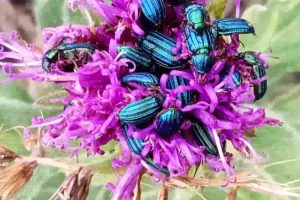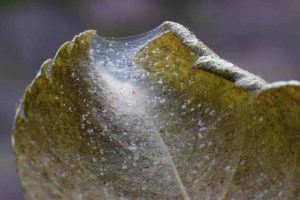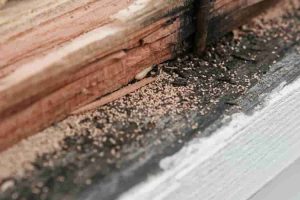No one wants to discover they have a termite problem, but early detection is key to keeping your home safe and sound. Often, we miss the initial warning signs, which can lead to more extensive damage down the line. One of the earliest signs of a termite infestation is finding mud trails on your exterior walls. These small, pencil-thin trails, also called “shelter tubes,” are used by termites to travel between their nests and your home.
Another tell-tale sign is noticing any blisters, cracks, or sags on wooden surfaces. When we knock on timber around the house and it sounds hollow, it’s likely that termites have eaten away at the inside of the wood. You might also spot bubbling paint or discolored wallpaper, which are signs that termites have been moving underneath the surface.
We should also keep an eye out for swarms of flying insects around our property. These swarms often indicate that termites are nearby and could be looking to establish a new colony within our home. By staying vigilant and recognizing these signs, we can act quickly and prevent a minor infestation from becoming a major problem.
Understanding Termites and Infestation
To protect our homes from termites, we must recognize different termite types, identify signs of their presence, and distinguish them from other pests.
Types of Termites
There are several types of termites that we are likely to encounter: subterranean, drywood, and dampwood termites.
Subterranean termites live in the soil, creating mud tubes to travel between their nests and food sources. These are the most common and aggressive type and can cause extensive damage.
Drywood termites nest in dry wood and don’t need soil contact. They are known for creating small, smooth galleries in wood.
Dampwood termites prefer moist wood, often found in decaying trees, logs, or damp areas. They are less common in homes but can still cause damage if moisture issues persist.
Understanding these types helps us detect and prevent infestations efficiently.
Signs of Termite Presence
Detecting termites early can save us from severe damage. Key signs include:
- Mud tubes: Subterranean termites build these to travel and protect themselves.
- Wood damage: Termites hollow out wood, causing it to sound hollow when tapped.
- Discarded wings: We might find these after a termite swarm, indicating that termites are in the process of establishing a new colony.
- Blistering or buckling wood: Noticeable deformations in floors or walls can be a sign of termite activity.
- Frass: This term refers to termite droppings, which look like small, wood-colored pellets.
By being vigilant about these signs, we can catch infestations early.
Comparing Termites with Other Pests
Termites are often confused with ants, especially white ants.
Termite workers are light-colored and have straight antennae, whereas ants are darker with elbowed antennae.
Soldier termites have large jaws and a pronounced head, while ant soldiers have distinct waistlines.
Termites also have wings of equal length, compared to ants whose front wings are longer than the back ones.
Knowing these differences helps us accurately identify and address infestations, ensuring we take the correct actions.
Identifying Early Warning Signs
Recognizing early warning signs of termite infestation can save us from extensive damage and costly repairs. We need to look for visual indicators, listen for sounds, and note physical changes in our environment.
Visual Indicators
Mud Tubes
Termites construct mud tubes as protective tunnels. These tubes can often be found along foundations, walls, and other structures. Their presence is a significant sign of termite activity inside our homes.
Discarded Wings
Seeing discarded wings around windowsills or doorways can indicate that swarmers, winged termites, have entered our home looking to establish a new colony.
Cracked Paint
Termite activity can cause paint on walls and wood to bubble or crack. This occurs because termites introduce moisture into the wood, causing these visible signs.
Frass
Frass, or termite droppings, resembling tiny wood pellets, is another visual clue. We should look for small piles of these droppings near wooden structures.
Audible and Physical Clues
Hollow-Sounding Wood
Tapping on wooden surfaces and hearing a hollow sound can mean that termites have eaten away the interior, leaving a thin outer layer.
Buckling Floors and Walls
Structural damage like buckled floors and walls can result from termites consuming the wood. This can cause the wood to warp or sag.
Swarms
Spotting swarms of termites, particularly after rain, is a clear sign of termites looking to establish new colonies. These swarms are usually attracted to light sources.
Property and Environmental Factors
Structural Damage
Termites can cause various types of structural damage, including weakened support beams and compromised foundations. We need to regularly inspect these areas for signs of damage.
Moisture
Termites are drawn to moisture. Leaky pipes, poor drainage, and inadequate ventilation can create an environment conducive to termite infestation.
Environmental Conditions
Certain environmental conditions, like having mulch or wood piles near our home’s foundation, can attract termites. Ensuring these materials are kept away from our home can help in preventing infestations.
By paying attention to these signs and taking proactive steps, we can better protect our homes from the damaging effects of termites. Regular inspections and early detection are key elements in termite control and prevention.
Prevention and Early Intervention
To protect our homes from termite damage, it is essential to employ preventative measures and conduct regular inspections. These steps help maintain the structural integrity of our properties and reduce the risk of infestations.
Termite-Proofing Your Home
Termite-proofing involves a range of measures aimed at deterring termites from invading our homes. Using physical barriers like metal mesh or sand around the foundation can prevent termites from entering. Chemical barriers, such as soil treatments, create a toxic zone that termites cannot cross.
Baiting systems are also effective. They involve placing bait stations around the property to attract termites, which then consume the bait and spread it to the colony. Wood treatments can protect wood from becoming a food source for termites. Applying borates to wooden structures makes the wood resistant to termites.
Ensuring proper ventilation and drainage around the property can help keep the wood dry, as termites are attracted to moist environments. Simple maintenance tasks like keeping firewood away from the house and trimming tree branches can make a significant difference in termite prevention.
Regular Inspections and Monitoring
Regular inspections by professionals can detect signs of termites early. A professional termite inspection includes a thorough check of the property’s hidden areas, such as crawl spaces and attics, where termites are likely to be found.
Homeowners can also monitor for signs of termites between professional inspections. Some indicators include hollow-sounding wood, mud tubes, and discarded wings. Early detection allows for prompt action, preventing extensive damage.
Installing monitoring stations around the property helps in tracking termite activity. These stations can reveal termite presence before extensive damage occurs, allowing us to initiate pest control measures quickly.
Working with a licensed pest control service ensures the most effective management plan is in place. Their expertise can guide us in choosing the right combination of treatments to protect our home from termites.
Professional Termite Management
In this section, we will focus on how to choose a reliable pest control service and explore the various termite treatment options available. Each approach is essential for effectively managing termite infestations and ensuring that your home remains termite-free.
Choosing the Right Pest Control Service
Selecting a qualified pest control company is crucial. First, verify that they have the necessary licenses and certifications to operate. Check for testimonials or reviews from previous customers to gauge their reputation and reliability.
It’s important to ensure the pest controller has experience with termite management. Ask about their training and the specific termite inspection methods they use.
Consider the range of services offered. Some companies provide ongoing monitoring and maintenance, which can help in early detection of termite activity. We recommend getting multiple quotes to compare prices and services. Remember, the cheapest option is not always the best when it comes to protecting your home from termites.
Termite Treatment Options
We need to familiarize ourselves with the various termite treatments available. Liquid termiticides like bifenthrin, fipronil, imidacloprid, and permethrin are commonly used. These chemicals are applied to the soil around the home to create a barrier that kills or repels termites.
Termite baiting is another effective method. Baits containing a slow-acting toxin are placed around the property. Termites consume the bait and carry it back to the colony, gradually eliminating it. This method targets the entire colony and not just individual termites.
Fumigation is sometimes necessary for severe infestations. This process requires the home to be sealed and treated with gas to eliminate termites. It’s invasive but can be highly effective. Each treatment has its advantages and should be discussed with your pest control professional to determine the best fit for your situation.
On-Time Service

5 STAR SERVICE BASED ON 100+ GOOGLE REVIEWS
PET & FAMILY FRIENDLY TREATMENT

ALL YEAR-ROUND PROTECTION
Take Back Control Now
8
REASON TO CHOOSE SAFE PEST CONTROL
- Guarantee protection all year-round
- 30 Years Collective Experience
- An impeccable reputation across Sydney's Suburbs
- Certified treatments & written Warranty On all work carried out
- Family Owned & Operated
- Rated #1 Pest Control In Sydney NSW
- No Mess, No Smell
- Family & Pet Friendly Treatments
REQUEST A QUOTE








